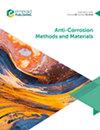Crevice corrosion behavior and mechanism of laser additive manufacturing nickel-based alloy under wedge-shaped crevice by using wire beam electrode
IF 2.6
4区 材料科学
Q2 METALLURGY & METALLURGICAL ENGINEERING
引用次数: 0
Abstract
Purpose The purpose of this study is to investigate the crevice corrosion behavior and mechanism of laser additive manufacturing (LAM) nickel-based alloy under wedge-shaped crevice. Design/methodology/approach First, the opening size of the wedge-shaped crevice was designed to 0.1, 0.3 and 0.5 mm by controlling the thickness of silicon rubber and the double-side adhesive tape. Then, one side of the glass sheet was stuck on the silicon strip and keep the electrodes of Rows 1 and 2 outside the crevice as a reference, and the opposite side was stuck to the wire beam electrode by silica gel. Findings The current density with a maximum value of 5.7 × 10−6 A/cm2 was observed at the crevice opening of 0.5 mm, while the lowest value of 9.2 × 10−7 A/cm2 was found at the crevice opening of 0.1 mm. In addition, the corrosion resistance at the inside of the crevice is higher than that at the outside and the middle of the crevice. It means that the internal width of the wedge-shaped crevice tends toward 0, which hinders the migration of ions in the corrosive medium. The generation of corrosive products further reduce the crevice size to cause the inhibition of corrosion at the inside of the crevice as well. Originality/value The multilayer and multipath LAM component is prepared to show the complex microstructure, which made the corrosion behavior and mechanism at wedge-shaped crevice nondeterminacy.线束电极激光增材镍基合金在楔形缝隙中的缝隙腐蚀行为及机理
目的研究激光增材制造镍基合金在楔形缝隙中的缝隙腐蚀行为及其机理。设计/方法/方法首先,楔形缝隙的开口尺寸设计为0.1、0.3和0.5 mm,通过控制硅橡胶和双面胶带的厚度。然后,将玻璃片的一侧粘贴在硅条上,并将第1行和第2行的电极保持在缝隙外部作为参考,并且通过硅胶将相对侧粘贴到线梁电极。Findings电流密度最大值为5.7 × 10−6 在0.5的缝隙开口处观察到A/cm2 mm,而9.2的最低值 × 10−7 在0.1的缝隙开口处发现A/cm2 此外,缝隙内部的耐腐蚀性高于缝隙外部和中间的耐腐蚀性能。这意味着楔形缝隙的内部宽度倾向于0,这阻碍了离子在腐蚀介质中的迁移。腐蚀性产物的产生进一步减小了缝隙尺寸,从而也抑制了缝隙内部的腐蚀。独创性/价值制备多层多路径LAM组件以显示复杂的微观结构,这使得楔形缝隙处的腐蚀行为和机理不确定。
本文章由计算机程序翻译,如有差异,请以英文原文为准。
求助全文
约1分钟内获得全文
求助全文
来源期刊

Anti-corrosion Methods and Materials
工程技术-冶金工程
CiteScore
2.80
自引率
16.70%
发文量
61
审稿时长
13.5 months
期刊介绍:
Anti-Corrosion Methods and Materials publishes a broad coverage of the materials and techniques employed in corrosion prevention. Coverage is essentially of a practical nature and designed to be of material benefit to those working in the field. Proven applications are covered together with company news and new product information. Anti-Corrosion Methods and Materials now also includes research articles that reflect the most interesting and strategically important research and development activities from around the world.
Every year, industry pays a massive and rising cost for its corrosion problems. Research and development into new materials, processes and initiatives to combat this loss is increasing, and new findings are constantly coming to light which can help to beat corrosion problems throughout industry. This journal uniquely focuses on these exciting developments to make essential reading for anyone aiming to regain profits lost through corrosion difficulties.
• New methods, materials and software
• New developments in research and industry
• Stainless steels
• Protection of structural steelwork
• Industry update, conference news, dates and events
• Environmental issues
• Health & safety, including EC regulations
• Corrosion monitoring and plant health assessment
• The latest equipment and processes
• Corrosion cost and corrosion risk management.
 求助内容:
求助内容: 应助结果提醒方式:
应助结果提醒方式:


